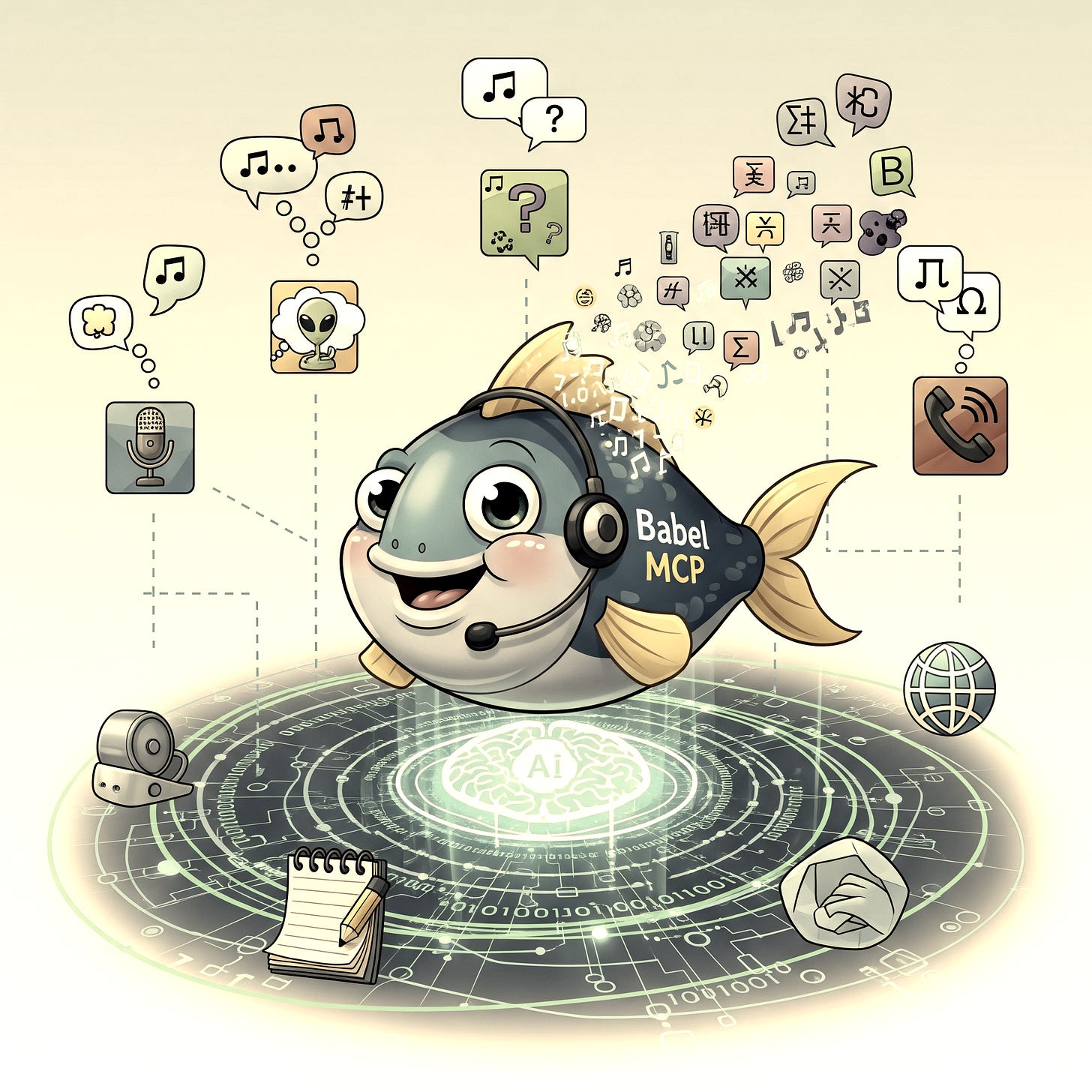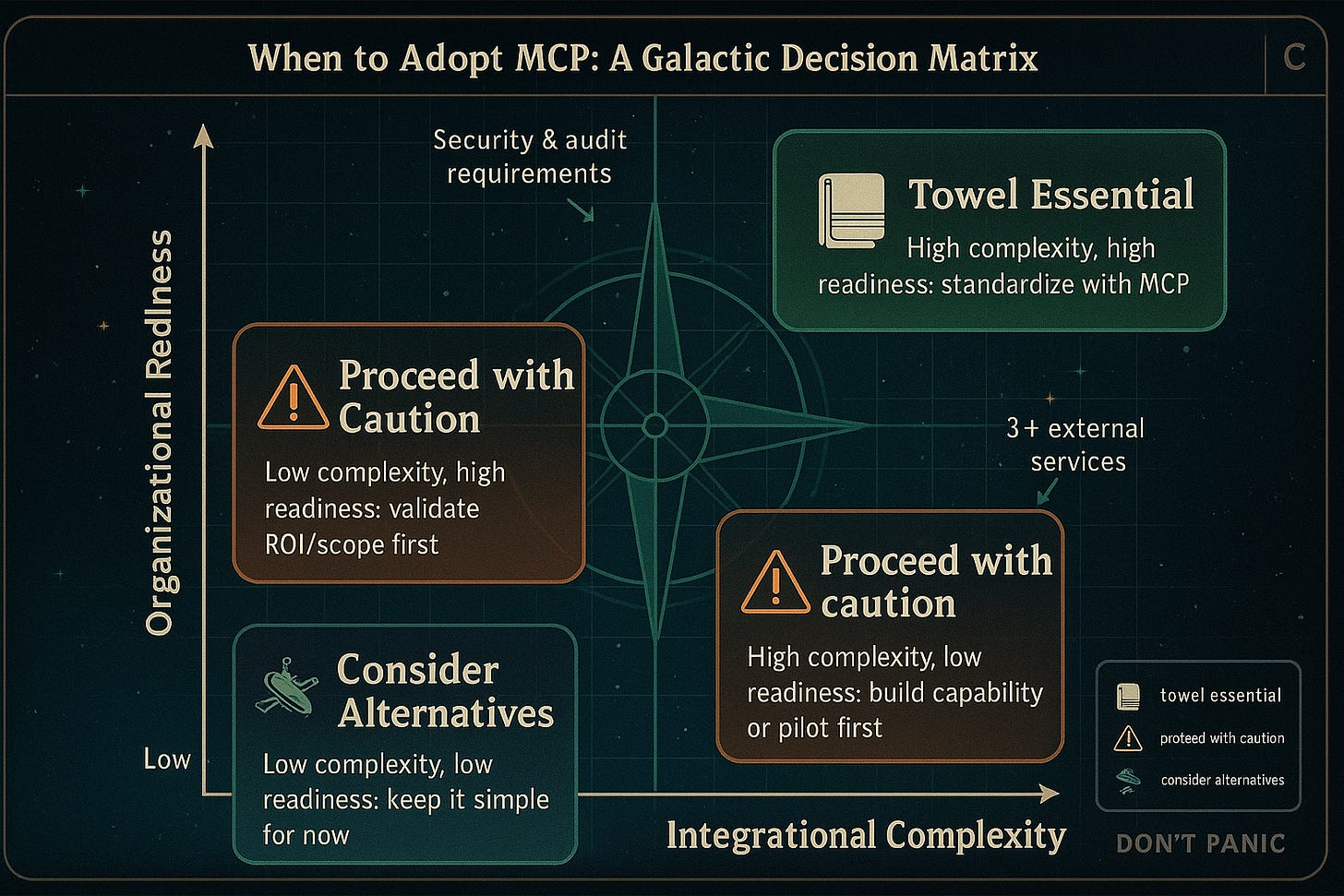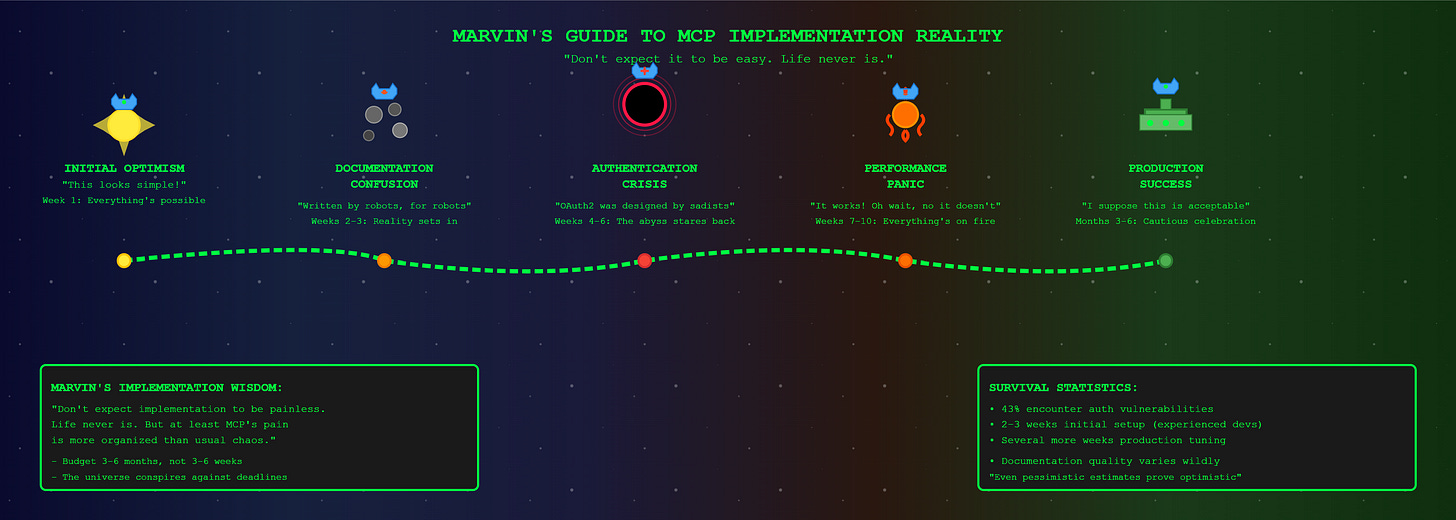The Hitchhiker’s Guide To Model Context Protocol (MCP)
“Don’t panic. This is just another protocol to revolutionize everything you thought you knew about AI integration.”
🌌 Introduction: Don’t Panic (About AI Integration)
Picture this: You’re building an AI assistant for your organization when suddenly you realize it needs to connect to seventeen different systems, each with its own authentication method, data format, and documentation written by someone who clearly never expected humans to read it. The current state of AI integration resembles the chaos of galactic hitchhiking before Ford Prefect handed Arthur his towel—you know you need to get somewhere, but the transportation options are baffling and potentially dangerous.
According to McKinsey’s latest research, 78% of organizations now use AI in at least one function, yet only 17% see a 5% or more EBIT impact from generative AI¹. Meanwhile, Gartner reports that 95% of IT leaders cite integration issues as the primary impediment to AI adoption². This isn’t just a minor inconvenience—it’s a $2.41 trillion annual technical debt crisis³ that makes the complexity of galactic bureaucracy look refreshingly straightforward.
Enter MCP (Model Context Protocol): potentially the Babel Fish of AI integration. Like that small, yellow, leech-like creature that Douglas Adams imagined, MCP appears deceptively simple while promising to solve an enormously complex universal communication problem. The question isn’t whether AI integration needs standardization—the data makes that painfully clear. The question is whether MCP is your towel or just another well-intentioned protocol destined to join the graveyard of enterprise integration standards.
Remember the most important advice from The Guide: Don’t Panic. This article will help you navigate the MCP universe with your sanity intact, armed with actual data instead of marketing brochures and a healthy dose of Adams-inspired skepticism about solutions that seem too elegant to be true.
🐟 Chapter 1: The Babel Fish Phenomenon
What the Babel Fish accomplished for galactic communication, MCP promises for AI integration. Adams wrote that the Babel Fish was “small, yellow, leech-like, and probably the oddest thing in the Universe” because it solved “more problems than could be reasonably expected” while simultaneously "causing more and bloodier wars than anything else in the history of creation."⁴ This duality perfectly captures the promise and peril of MCP adoption.
The MCP Babel Fish Explained: Model Context Protocol functions as a universal translator between your AI system and external services, converting their various “API languages” into something your AI can understand seamlessly. Instead of building custom integrations for each service—what computer scientists call the N×M problem where N services require M different integration approaches—MCP proposes a standardized communication layer that handles authentication, authorization, and data exchange through a single protocol specification⁵.
The technical architecture builds on JSON-RPC, a lightweight remote procedure call protocol that handles the complexity of service discovery, capability negotiation, and secure data transmission⁶. Early adopters including Block, Apollo, Zed, Replit, Codeium, and Sourcegraph have implemented MCP servers, contributing to an ecosystem that has grown to over 16,000 MCP implementations since Anthropic’s announcement⁷.
But here’s where Adams’ wisdom about universal translators becomes prophetic. Just as the Babel Fish eliminated communication barriers only to create new forms of conflict, MCP’s elegant solution to integration chaos introduces its own categories of complexity. Security researchers at Equixly found that 43% of current MCP implementations contain command injection vulnerabilities⁸, while developers report significant learning curves and documentation challenges that one frustrated engineer described as "the worst documented technology I have ever encountered."⁹
The Philosophical Implications: If something this useful could emerge from the chaos of modern software development, what does that say about the universe of enterprise integration? Adams would likely note that any protocol capable of solving the N×M integration problem must necessarily create M×P new problems, where P represents the number of ways humans can mis-implement elegant solutions.
🚀 Chapter 2: The Heart of Gold Approach
Adams’ Heart of Gold spaceship achieved impossible things through its Infinite Improbability Drive—MCP achieves the seemingly impossible task of standardizing AI integrations through elegant protocol design. But unlike the Heart of Gold’s tendency to transform crews into sofas or randomly materialize whale and bowl of petunias, MCP’s improbability lies in its potential to actually work in enterprise environments.
The Improbability of Success: Given the history of failed integration standards (remember SOAP? CORBA? The entire WS-* stack?), what makes MCP different? The answer lies in timing and scope. Previous standardization efforts attempted to solve everything for everyone. MCP focuses specifically on the context-aware communication needs of AI systems, arriving precisely when organizations need it most¹⁰.
Core Components Breakdown:
The MCP architecture addresses three fundamental challenges that have plagued AI integration efforts. First, secure authentication and authorization occur through a capability-based security model that prevents unauthorized access to external resources—because nobody wants Vogons accessing their customer database¹¹. The protocol handles OAuth2 flows, API key management, and fine-grained permission controls without requiring each AI system to implement these security patterns independently.
Second, standardized data exchange formats eliminate the translation chaos that currently consumes developer productivity. Instead of writing custom parsers for each service’s unique response format, MCP servers handle normalization and provide consistent data structures that AI systems can process reliably¹². This standardization extends to error handling, progress reporting, and resource lifecycle management.
Third, built-in resource management prevents the infinite loops and resource exhaustion that plague traditional integration approaches. MCP includes timeout handling, rate limiting, and circuit breaker patterns that protect both AI systems and external services from cascade failures¹³. Unlike certain space-time phenomena that create paradoxes, MCP’s resource management actually helps prevent them.
However, the architectural elegance comes with engineering complexity that early adopters are discovering the hard way. Implementation requires understanding JSON-RPC semantics, managing persistent connections, handling bidirectional communication, and implementing proper error recovery mechanisms¹⁴. The learning curve measures in weeks rather than hours, and production deployments require infrastructure considerations that aren’t immediately obvious from the protocol specification.
🌍 Chapter 3: Life, the Universe, and Everything (About MCP Adoption Decisions)
The Answer to the Ultimate Question of MCP adoption might not be 42, but it does require asking the right questions with the right framework. Like in the book, having the correct answer means nothing without understanding the question, and MCP adoption decisions demand similar philosophical rigor applied to enterprise technology choices. Douglas Adams would appreciate the irony that the most important questions about MCP adoption can’t be answered with simple yes-or-no responses, much like how the Ultimate Question of Life, the Universe, and Everything required more precision than “what’s the meaning of it all?”
When MCP Is Your Towel (Essential Scenarios):
Building multi-service AI assistants represents the clearest use case for MCP adoption. When your AI system needs to interact with more than three external services, the integration complexity begins to justify protocol standardization. Organizations like those early adopters chose MCP precisely because their AI assistants required seamless access to multiple development tools, customer databases, and external APIs¹⁵. In these scenarios, MCP functions like Ford Prefect’s towel—an essential tool you’ll need to rely on when everything else fails.
Security-conscious organizations benefit from MCP’s standardized approach to authentication and authorization. Instead of implementing custom security patterns for each integration, teams can leverage MCP’s built-in security model that provides audit trails, permission management, and secure credential handling¹⁶. This is particularly valuable for organizations with Paranoid Android-level security requirements, where any deviation from established security patterns creates compliance risks.
Long-term strategic AI initiatives justify MCP adoption when organizations plan for Restaurant at the End of the Universe timelines. The protocol provides architectural consistency that supports scaling from pilot projects to enterprise-wide AI deployment. Early adopters report that MCP’s standardization reduces maintenance overhead and enables faster integration of new services as AI capabilities expand¹⁷.
When MCP Might Be Overkill (The Slartibartfast Situations):
Simple, single-purpose applications often don’t justify MCP’s architectural complexity. If your AI system only needs to access one or two well-documented APIs with stable interfaces, implementing MCP resembles designing fjords when you only need a small pond. The protocol overhead and learning curve may exceed the benefits of standardization¹⁸.
Immediate prototype needs conflict with MCP’s emphasis on proper implementation. When business stakeholders demand proof-of-concept demonstrations in days rather than weeks, traditional REST API integration often provides faster time-to-value. Sometimes you just need to catch the next spaceship rather than building the optimal long-term transportation infrastructure¹⁹.
Organizations without dedicated integration expertise face significant implementation challenges. MCP requires understanding distributed systems concepts, security patterns, and protocol-level debugging that may exceed current team capabilities. The technology demands investment in learning and infrastructure that some organizations aren’t positioned to support²⁰.
The 42-Point Evaluation Framework (Because Some Traditions Must Be Honored):
Your MCP decision requires a systematic framework that acknowledges both technical realities and organizational constraints while maintaining appropriate skepticism about vendor promises.
Technical Compatibility Assessment:
Begin by evaluating your current AI system architecture and integration requirements. Organizations need to assess whether their AI platforms support MCP protocol communication, whether existing integrations can be migrated incrementally, and whether the development team possesses the protocol implementation expertise required for production deployment²¹. Teams should also evaluate performance requirements, security constraints, and scalability needs that might conflict with MCP’s architectural assumptions.
Organizational Readiness Evaluation:
Examine both technical capacity and strategic alignment factors. This includes assessing development team expertise in distributed systems and protocol implementation, organizational tolerance for emerging technology risks, and budget allocation for the implementation timeline that production deployments typically require²². Teams should honestly evaluate whether they can commit adequate resources to proper implementation rather than attempting shortcuts that create security vulnerabilities.
Resource Allocation Analysis:
Consider requirements extending beyond initial development costs to include ongoing operational overhead, security monitoring, and protocol evolution management. Organizations need capacity for debugging protocol-level issues, maintaining secure authentication systems, and adapting to ecosystem changes as the MCP standard evolves²³. Budget planning should account for potential consulting costs, training investments, and infrastructure requirements that may not be immediately obvious from protocol documentation.
Timeline and Risk Assessment:
Balance first-mover advantages against implementation stability concerns. Early adoption provides access to emerging ecosystem benefits but increases risks of security vulnerabilities, protocol instability, and technical debt accumulation²⁴. Organizations should assess their tolerance for these risks against the strategic value of standardized AI integration capabilities.
Teams should assess their current integration pain points, future AI strategy, security requirements, and development capacity before committing to implementation. The decision framework needs to account for both immediate costs and long-term strategic value, while honestly evaluating whether the organization can handle both MCP’s benefits and its inevitable complications.
Decision Documentation Framework:
Successful organizations maintain decision documentation that captures both quantitative assessments and qualitative factors that influence adoption timing. This should include technical compatibility results, resource allocation commitments, risk mitigation strategies, and success criteria for evaluating implementation progress²⁵.
The documentation should address contingency planning for scenarios where MCP implementation encounters significant obstacles, protocol evolution creates breaking changes, or organizational priorities shift during implementation. Teams benefit from explicit criteria for determining whether to continue MCP implementation, pivot to alternative approaches, or delay adoption until ecosystem maturity improves²⁶.
Next Steps for Different Scenarios:
Immediate Adoption Path: Makes sense for organizations with strong protocol implementation expertise, clear integration pain points, and tolerance for emerging technology risks. These teams should begin with pilot implementations that focus on high-value integration scenarios while building internal expertise²⁷.
Delayed Adoption Strategy: Suits organizations that need MCP’s integration benefits but lack current implementation capacity or prefer waiting for ecosystem maturity. These teams should monitor protocol evolution, build relevant technical expertise, and identify specific integration scenarios that would justify future MCP adoption²⁸.
Alternative Exploration Route: Appropriate for organizations where MCP’s architectural assumptions don’t align with current needs or constraints. Teams should evaluate existing integration platforms, API gateway solutions, and custom integration approaches that might provide similar benefits without protocol adoption overhead²⁹.
🤖 Chapter 4: Marvin’s Guide to Implementation Realities
Even Marvin the Paranoid Android would appreciate MCP’s methodical approach to solving integration depression, though he’d undoubtedly point out that any protocol promising to solve universal communication problems will inevitably create universe-sized headaches for the people implementing it. Let’s examine the implementation realities with appropriately pessimistic honesty about what early adopters learned the hard way.
Getting Started Without a Brain the Size of a Planet:
Practical first steps for mere mortals begin with understanding that MCP implementation requires more than reading the specification document. Developers need familiarity with JSON-RPC protocols, WebSocket or stdio communication patterns, and async programming concepts before attempting their first MCP server³⁰. The official documentation provides code examples, but production implementations require handling edge cases, error conditions, and performance optimization that aren’t immediately obvious from tutorial materials.
Setting up a development environment involves installing MCP SDKs, configuring authentication providers, and establishing secure communication channels between AI systems and MCP servers. Early implementers report spending 2-3 weeks on initial setup and basic implementation, followed by several more weeks optimizing for production use³¹. This timeline assumes experienced developers; teams new to protocol development should budget additional learning time.
Migration Strategies:
Moving from your current mess of integrations to MCP requires an adapter-first approach that acknowledges existing technical debt while building toward standardization³². Successful migrations begin by wrapping existing APIs with MCP servers rather than attempting wholesale replacement of working integrations. This incremental strategy allows teams to gain MCP experience while maintaining operational stability.
The migration process involves identifying high-value integration candidates, implementing MCP wrappers for existing APIs, and gradually expanding MCP coverage as team expertise develops. Organizations should expect 6–12-month migration timelines for complex environments, with careful attention to authentication changes, performance impacts, and user experience during transition periods³³.
Common Pitfalls:
Early adopters discovered several categories of problems that teams can avoid with proper preparation. Authentication complexity represents the most frequent stumbling block, particularly when integrating services with different OAuth2 implementations or custom security requirements³⁴. Production deployments require robust error handling, connection management, and failover strategies that development environments don’t expose.
Performance optimization becomes critical when MCP servers handle high-throughput scenarios or large data transfers. The protocol’s emphasis on context preservation can create memory pressure and latency issues that require careful tuning³⁵. Security implementations demand particular attention to input validation, command injection prevention, and privilege escalation risks that standard API integrations might handle differently.
Resource Requirements:
Time, talent, and technical infrastructure needs exceed what marketing materials typically suggest. Development teams require 3-6 months to achieve production readiness, assuming experienced architects and dedicated development resources³⁶. Infrastructure requirements include secure hosting for MCP servers, monitoring systems for protocol-level debugging, and backup communication channels for failover scenarios.
Technical staffing needs include developers familiar with protocol implementation, security engineers capable of reviewing authentication patterns, and operations personnel who can troubleshoot distributed system issues. Organizations should budget for training, external consulting, or hiring specialists rather than assuming existing teams can absorb MCP implementation alongside current responsibilities³⁷.
The Reality Check:
MCP implementation requires significantly more investment than building Deep Thought, but substantially less than designing the Earth. Success depends on realistic timeline expectations, adequate resource allocation, and accepting that elegant solutions often create their own categories of complexity. Teams that approach MCP with appropriate caution and preparation typically achieve their integration goals, while those expecting simple solutions discover they’ve traded familiar problems for exotic new ones.
📡 Chapter 5: The Restaurant at the End of the Integration Universe
Where MCP fits in the grand scheme of AI development might outlast the Earth itself, though Adams would remind us that any technology capable of solving fundamental communication problems will inevitably create new categories of existential questions. The current ecosystem evolution suggests we’re witnessing either the emergence of a truly useful standard or the most elaborate example yet of enterprise software’s tendency toward infinite complexity.
Current Ecosystem State:
We’re roughly at the point where mice are just starting to run the experiments, with early adoption metrics suggesting genuine market momentum rather than vendor-driven hype. Investment activity supports the growth trajectory, with AI infrastructure spending increasing sixfold to $13.8 billion and global AI infrastructure projected to reach $3 trillion by 2029³⁸.
However, market maturity indicators suggest caution about declaring victory too early. While adoption metrics show impressive growth, implementation quality varies significantly across the ecosystem. Developer experience reports range from enthusiastic endorsement to harsh criticism about documentation quality and implementation complexity, suggesting the ecosystem still faces growing pains typical of emerging standards.
The Network Effect:
Why early adoption matters but timing your entry correctly matters more. Network effects in protocol adoption create winner-take-all dynamics where dominant standards achieve exponential value while alternatives face extinction. MCP benefits from Anthropic’s position in the AI ecosystem and genuine technical advantages over custom integration approaches, but success isn’t guaranteed³⁹.
Early adopters gain competitive advantages through reduced integration costs, faster time-to-market for AI features, and access to expanding ecosystem resources. However, premature adoption creates risks of implementation instability, security vulnerabilities, and technical debt if the protocol evolves significantly. Organizations must balance first-mover advantages against the costs of betting on emerging standards⁴⁰.
Future Implications:
How MCP might reshape AI development depends on whether the protocol can scale beyond its current early-adopter community while maintaining architectural coherence. Success scenarios involve MCP becoming the standard communication layer for AI systems, enabling plug-and-play integration of new services and reducing the custom development overhead that currently limits AI deployment speed⁴¹.
The broader implications extend beyond technical efficiency to organizational capability development. Standardized AI integration protocols could accelerate AI adoption across industries by reducing the specialized knowledge required for complex implementations. This democratization effect might enable smaller organizations to deploy sophisticated AI systems without building extensive integration expertise internally⁴².
Potential Complications:
Just as the Babel Fish “caused more and bloodier wars than anything else in the history of creation,” consider what challenges universal AI integration might introduce. Standardized communication protocols could enable more sophisticated attacks against AI systems, create single points of failure across multiple organizations, and reduce diversity in security approaches that currently provide protection through obscurity³⁴.
Market concentration represents another concern, where successful protocol standardization might consolidate power among platform providers who control MCP ecosystem development. Organizations adopting MCP need contingency plans for scenarios where protocol evolution favors large platform providers over independent obscurity⁴³.
[Visualization Placeholder: Ecosystem evolution timeline showing current state (“Early Adoption Phase”) leading to potential futures including “Universal Standard,” “Market Fragmentation,” and “Next Protocol Emerges,” with probability estimates and key decision points marked]
🌟 Chapter 6: So Long, and Thanks for All the APIs
The Model Context Protocol represents something larger than just another integration standard—it demonstrates how solving fundamental communication problems can simultaneously create new categories of challenges. Understanding this duality proves essential for successful adoption, whether organizations choose immediate implementation, delayed adoption, or alternative approaches.
Final Wisdom from the Guide:
Like Arthur Dent learning to navigate an improbable universe filled with both wonder and danger, success with AI integration requires preparation, good guidance, robust security practices, and maintaining your sense of humor when elegant solutions create their own brand of chaos. The most important preparation involves developing organizational capability to evaluate emerging technologies objectively, implement them securely, and adapt when reality deviates from vendor promises⁴⁸.
Remember: the answer might be 42, but you still need to figure out the question.
References
McKinsey & Company. “The State of AI in 2024.” McKinsey Global Survey on AI, 2024.
MIT Sloan Management Review. “How to Manage Tech Debt in the AI Era.” 2024.
Adams, Douglas. “The Hitchhiker’s Guide to the Galaxy.” Pan Books, 1979.
Anthropic. “Model Context Protocol Overview.” Official Documentation, 2024.
Medium. “Why Model Context Protocol Uses JSON-RPC.” Dan Avila, 2024.
A16Z. “A Deep Dive into MCP and the Future of AI Tooling.” 2024.
Newsletter by Victor Dibia. “No, MCP’s have NOT won (Yet).” 2024.
ModelContextProtocol.io. “Architecture Documentation.” 2024.
Pillar Security. “The Security Risks of Model Context Protocol.” 2024.
Milvus. “How Does MCP Differ from REST/GraphQL/gRPC APIs.” 2024.
Ardor Cloud. “Early Adopters MCP Open Source Implementations.” 2024.
Medium. “Model Context Protocol and Its Limitations.” C. Kekula, 2024.
Traction Technology. “Top Ten Steps to Evaluate Emerging Technologies.” 2024.
Intellective. “Calculating Timelines for Digital Transformation.” 2024.
Medium. “Building an MCP Server as an API Developer.” Heeki, 2024.
MarkTechPost. “Migrating to MCP: An Adapter-First Playbook.” 2025.
ThinhDangGroup. “MCP Production-Ready Implementation Guide.” 2024.
Medium. “MCP Server: MCP-dev vs Deployed.” Paul D. Short, 2024.
Christian Posta. “Enterprise Challenges with MCP Adoption.” 2024.
Blog.christianposta.com. “Enterprise Challenges with MCP Adoption.” 2024.
The Open Group. “TOGAF Enterprise Architecture Framework.” 2024.








